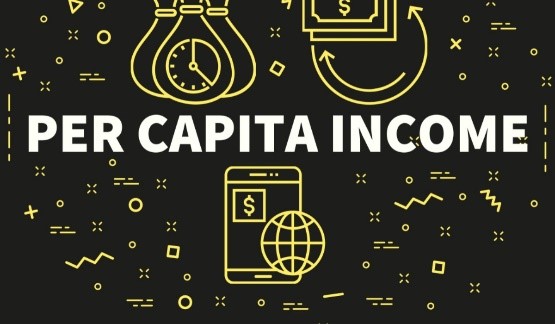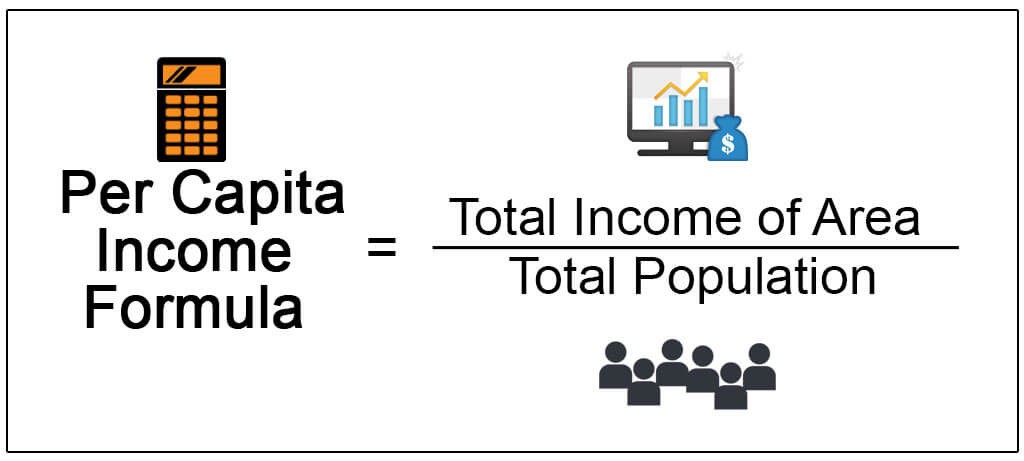
Disclaimer: Copyright infringement not intended.
Context
- All India annual per capita Net National Income (NNI) for 2014-15 and 2022-23 at current prices are Rs. 86,647 and Rs. 1,72,000 respectively illustrate achievement in this regard.
- This information was given by the Minister of State (I/C) for the Ministry of Statistics and Programme Implementation, in a written reply in the Rajya Sabha.
Decoding Per Capita Income
- Per capita income (PCI) or total income measures the average income earned per person in a given area (city, region, country, etc.) in a specified year. It is calculated by dividing the area's total income by its total population.
- PCI compares and assesses the economic situations of countries with varying population sizes.
- The measurement of a country's per capita income is done by dividing the total national income of a particular country or state by the population in that specific geographical region.
- When calculating a country's PCI, every individual is taken into account. The calculation includes men, women, children, and babies. This is mainly because the measurement considers the entire country's population or specific geographical location.

Uses of Per Capita Income
- PCI calculation is used in various fields of statistics and economics.
The various uses of PCI are:
Gross Domestic Product Per Capita
- The GDP Per Capita calculates a country's economic output by the number of people in that country.
- We have to divide a nation's total economic domestic production by that nation's population. The formula for calculating GDP Per Capita is:
GDP Per Capita = Gross Domestic Product/ Population
Gross National Income Per Capita
- To determine the Gross National Income per Capita, we have to take into account Gross Domestic Product Per Capita along with the value generated by the people of a country living abroad.
Other Uses
- Per Capita Income is used to find out an area's wealth or lack thereof.
- It is also used to find out the affordability of an area regarding data on real estate prices.
- Prominent business chains and owners consider an area's per capita income before opening a store branch or shop in a concerned area.
- The higher PCI of a place, the higher the chances of making considerable revenue. The chances of profitable revenue fall drastically in those places where PCI is low.

What are the Limitations of Per Capita Income?
- Despite being a commonly used measurement entity, per capita income comes with some limitations. Some of them are:
Inflation
- Per Capita Income doesn't count for an economy's inflation (the rate of price rise). Inflation deducts the power of purchases of consumers and limits income increase. This results in overstating the average income of a place's population.
International Comparisons
- Making international comparisons can be unfair and inaccurate. This is because it does not include the currency exchange rate in the measurements while calculating the per capita income. Some economies are known to use non-monetary activity and barter systems. Again, this is not considered in calculations of the per capita income.
Children
- Per Capita Income includes non-earning individuals like children and even newborn babies.
- When a country's average income is included, the babies or kids are counted even when they don't add to the income.
- Those economies and countries with lots of children will, therefore, get a distorted result when using the PCI parameter to calculate an economy's average income.
Savings
- The Per Capita Income calculations do not consider every individual's savings. An individual could have a lot of wealth from his savings, which he uses to maintain a high quality of livelihood but earns a meagre income. Hence, the calculations will still count the wealthy person as a very low-income earner and decrease the per capita income.
Welfare
- Per Capita Income is used to determine the living quality or livelihood in an area or geographical region. But the calculations do not count for quality of working conditions, literacy level, and overall health benefits.

Per Capita Income and Population: What is the relationship between them?
- When we divide the total income of a particular geographical location (say, a country or state) by population, we get Per Capita Income.
- PCI’s growth rate is roughly equal to the difference between the growth rates between income and population.
Low Per Capita Income
- Generally speaking, low per capita income means lower average income of people living in a country or a specific geographical location and lower standard of living.
What is the Per Capita Income of Rich Countries?
- The per capita income of rich countries (GDP PPP Per Capita of 2017) varies from US$128,647 (Qatar) to US$79,003 (Brunei).
Final Words
In conclusion, we can see that,
- Per Capita Income is a metric used to determine the amount of money earned per individual in a nation or geographical area.
- We will get PCI of a specific geographical location by dividing a population's total income by that area's population.
- This measurement helps in finding the average per-person income, which helps us ascertain the quality of living for a population in a specific area.
- Per Capita Income has both uses and limitations. It calculates Gross Domestic Product and Gross National Income Per Capita. However, it cannot consider factors such as inflation, poverty, savings and economic welfare.
|
PRACTICE QUESTION
Q. Which of the following are considered while determining the Per Capita Income?
a) Every individual's savings.
b) Currency Exchange Rate.
c) Inflation.
d) Non-earning individuals like children and even newborn babies.
1. a and c
2. b and d
3. d only
4. None of the above.
Correct Answer: Option 3
|

https://pib.gov.in/PressReleasePage.aspx?PRID=1913325#:~:text=Per%20Capita%20Income%20i.e.%20Per,89%2C641%20and%20%E2%82%B9104%2C811%20respectively.





